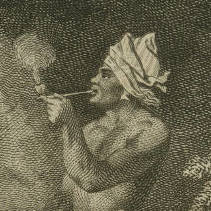Joseph Chatoyer
Joseph Chatoyer († March 14, 1795 on Dorsetshire Hill above Kingstown ) was a politician on St. Vincent .
Life
Some of the ancestors of the Garifunas came to St. Vincent with five slave ships from 1675 onwards . They overwhelmed the crew when boarding fresh water . As a result, they settled as Cimarrónes on St. Vincent. In the Peace of Paris in 1763 , Spain and France recognized British rule over St. Vincent. In 1778 French ships blocked the island and in 1779 they landed at Calliaqua near Fort Duvernette.
Joseph Chatoyer was married to Barauda Chatoyer. The British governor of St. Vincent signed a treaty of mutual recognition with Joseph Chatoyer, among others, which ended the first Caribbean war. In 1785, parts of the highlands were opened up by roads, which increased the settlement pressure from British settlers who drove their cattle into the Milpas of the Cimarones, which constituted a conflict and, according to the Cimarones, violated the treaty and led to the second Caribbean War. Chatoyer shared control of the inaccessible part of St. Vincent with DuValle. Chatoyer ruled over the French east side of St. Vincent. From 1787 to 1802 there was a civil war in Martinique in which Chatoyer entered into an alliance with the insurgents. In 1789, at the time of the French Revolution , James Seton was governor of St. Vincent and on April 9th a second attempt at the uprising in Demerara was registered.
At the end of February 1795, the British governor of Saint-Vincente James Seton declared martial law on the French citizens of St. Vincent and called the leaders to negotiations on March 8, 1795 in Kingstown .
On March 8, 1795 it became known in Kingstown that the Le Croix Estate in the Marriaqua Valley had been looted. British troops sent to the Marriaqua Valley captured 18 Garifunas.
On March 13, 1795, the combined forces of DuValle and Chatoyer, about 450 men, occupied Dorsetshire Hill over Kingstown. British troops under Ralph Abercromby attacked this position, with Joseph Chatoyer being killed by Major Alexander Leith.
With the death of Joseph Chatoyer, the francophone supporters of the uprising fell away. The British troops ended the uprising in June 1796 with several massacres of the Garifunas and deported some of them via Baliceaux to Roatán .
Individual evidence
- ↑ Archive link ( Memento of the original from January 22, 2011 in the Internet Archive ) Info: The archive link was inserted automatically and has not yet been checked. Please check the original and archive link according to the instructions and then remove this notice.
- ^ Charles Shephard, An historical account of the island of Saint Vincent
- ^ Gérard Lafleur, Amerindios, africanos, americanos , Association of Caribbean Historians. Conference ,, University of the West Indies (Mona, Jamaica), p. 124
- ↑ Gérard Lafleur, p. 69
- ↑ JORGE ALBERTO AMAYA, LAS IMÁGENES DE LOS NEGROS ( Memento of the original from December 25, 2016 in the Internet Archive ) Info: The archive link was inserted automatically and has not yet been checked. Please check the original and archive link according to the instructions and then remove this notice. , GARÍFUNAS EN LA LITERATURA, HONDUREÑA Y EXTRANJERA
| personal data | |
|---|---|
| SURNAME | Chatoyer, Joseph |
| ALTERNATIVE NAMES | Satuye, Joseph |
| BRIEF DESCRIPTION | Vincentian politician |
| DATE OF BIRTH | 18th century |
| DATE OF DEATH | March 14, 1795 |
| Place of death | Dorsetshire Hill, Kingstown |
